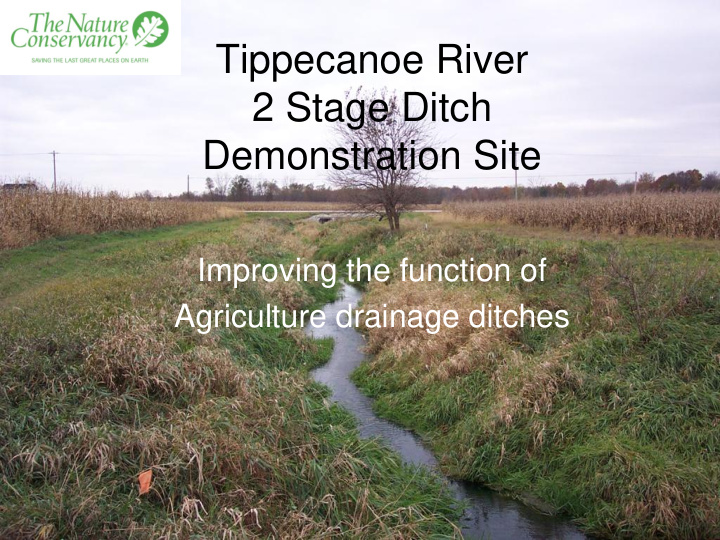



Tippecanoe River 2 Stage Ditch Demonstration Site Improving the function of Agriculture drainage ditches
• Received a IDEM 319 Grant to implement a 2 Stage Ditch • The Nature Conservancy supplemented additional dollars to the project. • County Surveyor (Dick Kemper) and NRCS District Conservationist (Sam St. Clair) selected 5 potential ditches and it was narrowed down to the Shatto. Selection criteria was flow rate of the ditch, visibility, cooperative landowners, amount of woody species present, soil types and landuse. • US Army Core granted permission to implement the practice. • Received approval from the County Drainage Board and all affected landowners • Hired monitoring contractors and bid out the excavation work.
Channel Evolution
Two-Stage Ditch Design Benches a Minimum of 2X Channel width, with 3 or 4 times being more desired
2 Stage Ditch Example • Benches on both sides = 10-14ft wide • 5-6 foot wide channel width
Current sampling design • Every other month we measure – habitat cover – Transient storage – Denitrification • Daily measurements include – Dissolved O 2 – Specific conductivity – Temperature – Turbidity – pH • Fish and invertebrate sampling once a year
Biological Response • Improvement of invertebrate community diversity in the treatment reach of ditch • Fish assemblages have increased in sensitivity, the treatment stretch is now holding more intolerant fishes. • Habitat is beginning to diversify – riffle/pool • Control still has no noticeable change
Monitoring Conclusions • 105,000 pounds of sediment removed from treatment reach each year. • 350% increase in denitrification potential • Isopods in 2 Stage Ditch segment went from 87% to 38% control section 79% to 58% • Sunfish species went from 1 to 4 species pre to post construction, control stayed at 1 specie • Total suspended solids (TSS) - control increased 4%, decreased 49% in treatment reach
Updates • Total reach N removal increases with 2 Stage Construction • % of N removal is the most when loads are the lowest – most effective when coupled with other strategies such as nutrient management. 1800 1600 Sand Removal FBOM Removal Bench Removal 1400 Total N Removal (g N/day) 1200 1000 800 600 400 200 0 Sep 06 Nov 06 Feb 07 Apr 07 Jun 07 Aug 07 Oct 07 Dec 07 Feb 08 Apr 08 Jun 08 Aug 08 Oct 08 Dec 08 Date
Before Construction
After Construction – Nov. 2007
Just after the first of the year we had 2 bank full events – Jan/Feb 2008
2-Stage Ditch Costs • Typical cost of 2-stage Construction – $8 - $ 12 per linear foot • Factors that affect your cost of Installation 1. Depth of the ditch (top of bank to waterline) 2. Width of ditch channel (and benches) 3. Amount of natural benches already starting to form 4. Absence of adequate area to spread spoil 5. Number of tile outlets to be addressed
Breakdown of Project costs
Expected Payback Period Two-Stage Costs $300,000 $39,932 Two-Stage Construction Cost ($) Two-Stage $250,000 4,000 Project Length (feet) Trapezoidal 30.0 Maintenance Frequency (yrs) $200,000 Cost ($) $3.00 Maintenance Cost ($ per linear foot) $150,000 0 $100,000 Traditional Maintenance $50,000 5 Maintenance Frequency (yrs) $3.00 Maintenance Cost ($ per linear foot) $0 0 10 20 30 40 50 60 70 80 90 100 14.0 Years The payback period is 14 years Solve
Implemented and Planned Projects
Closing Thoughts • When managed for water quality, headwater streams and ditches have tremendous potential to improve downstream health of rivers. • Many times ditches do not need maintenance performed but are viewed as functioning poorly because they “look bad” • As stream (ditch) habitat improves, fish and invertebrate communities improve. • Presence of vegetation is more essential than actual species type
Recommend
More recommend